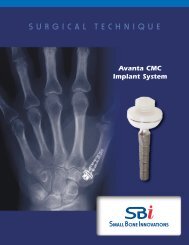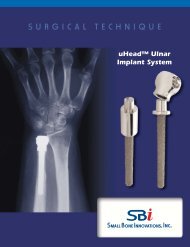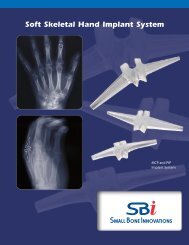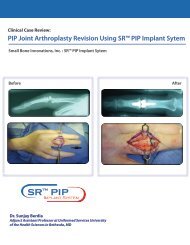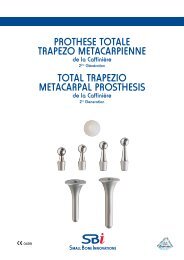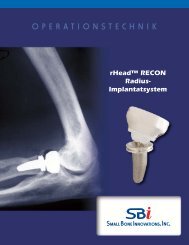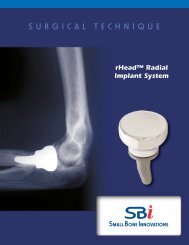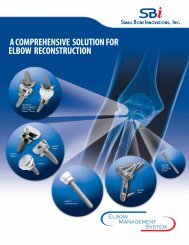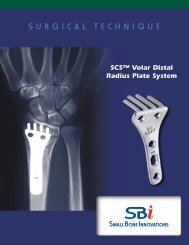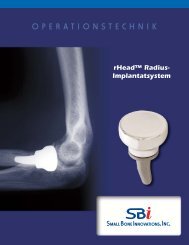PGT INSTRUmENTATIoN - Small Bone Innovations
PGT INSTRUmENTATIoN - Small Bone Innovations
PGT INSTRUmENTATIoN - Small Bone Innovations
You also want an ePaper? Increase the reach of your titles
YUMPU automatically turns print PDFs into web optimized ePapers that Google loves.
The mobile bearing design of the device is intended to reduce the shear and torque forces on the bearing, which can<br />
lead to loosening of either metal component, and to decrease stress at the metal/bone interface. The sloped sides are<br />
designed to improve the weight bearing characteristics of the talar component.<br />
Components<br />
Tibial Plate<br />
When viewed from the top, the tibial plate has a trapezoidal shape with rounded corners. This component is manufactured<br />
from cobalt chromium molydenum (CoCrMo) per ASTM F-75. This wedge is shaped to conform to the existing<br />
anatomy and, thereby, reduces the need to remove excess bone from inside the joint. On the proximal surface of the<br />
tibial plate, two parallel cylindrical barrels are positioned equidistant from the center of the plate running anterior to<br />
posterior for bone fixation. These cylinders must be inserted into hard subchondral bone.<br />
When viewed from the side, the plate is 2.5mm thick. The distal surface of the plate on which the mobile bearing articulates<br />
is flat and polished. The flat surface is designed to match the distal tibial cut.<br />
Tibial plates are available in five sizes with varying widths and lengths: extra-small (30mm x 30mm), small (32mm x<br />
30mm), medium (32.5mm x 35mm), large (33mm x 40mm), and extra large (33.5mm x 45mm).<br />
The tibial plate is coated on the bone-opposing surfaces with a titanium plasma spray coating. The tibial plate is intended<br />
to be press-fit without the use of cement, and should rest on anterior and posterior cortical bone.<br />
Mobile Bearing<br />
The polyethylene mobile bearing is manufactured from Ultra High Molecular Weight Polyethylene (“UHMWPE”), which<br />
is machined from medical grade extruded plate stock and conforms to ASTM F-648. The proximal surface of the mobile<br />
bearing is flat. The distal or talar surface is concave and has a central radial groove running from anterior to posterior.<br />
The walls are straight, and a 0.5mm stainless steel x-ray marker wire is placed 2mm from the proximal surface. The wall<br />
height varies to provide spacer thicknesses of 6mm, 7mm, 8mm, 9mm, and 10mm. Revision mobile bearings are available<br />
in sizes of 11mm, 12mm, 13mm, and 14mm.<br />
Talar Component<br />
The talar component is designed as an anatomical prosthesis to cover the talar dome, anterior, posterior, and medial and<br />
lateral facets. Like the tibial plate, this component is manufactured from CoCrMo. The talar component is designed to<br />
minimize the amount of bone that must be removed. From the apex of the dome, the walls slope outwards to conform<br />
to the normal bone anatomy. The component is offered in five sizes: extra-extra-small (28mm x 29mm), extra-small<br />
(30mm x 31mm), small (34mm x 35mm), medium (36mm x 35mm), and large (38mm x 35mm), and in both left and<br />
right-sided configurations.<br />
Viewed from the side, the proximal surface of the talar component is dome-shaped to conform to the talar dome of<br />
the normal ankle. A small, raised half-cylindrical ridge runs from anterior to posterior in the medial-lateral center of the<br />
dome. The purpose of this ridge is to constrain the medial/lateral motion of the mobile bearing.<br />
As with the tibial plate, the talar component is also provided with a titanium plasma spray coating.<br />
2<br />
S.T.A.R. ® Scandinavian Total Ankle Replacement Surgical Technique



